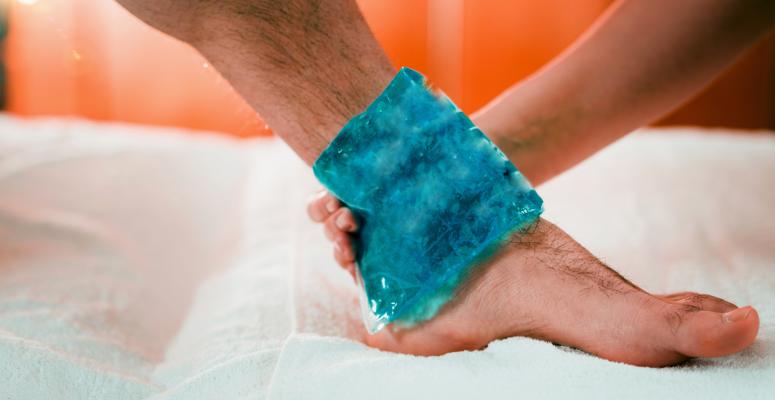
Sprained ankles can be quite painful, and many people will deal with at least one in their lifetime. After all, around 2 million people develop acute ankle sprains annually in the United States.
Sprained ankles can happen in a variety of instances, such as falling or landing awkwardly from a jump. This type of injury can keep you off your feet for weeks, making it hard to complete your day-to-day activities.
While you’re recovering, it’s important to know about the best ways to treat your damaged ankle, like whether ice or heat is more beneficial for a sprained ankle.
What is a sprained ankle?
A sprained ankle refers to an injury that causes your ankle to twist or roll in a painful, awkward manner. It results in the tearing of the ligaments that hold together your ankle bones, usually on the outer side of your ankle.
Some symptoms of a sprained ankle include:
- Pain when you put weight on it.
- Swelling.
- Bruising.
- Instability.
- Tenderness to the touch.
- Restricted range of motion.
Possible causes of sprained ankles
Most ankle sprains come from accidents that are usually out of our control, such as walking on an uneven surface or someone stepping on our foot during a sporting event. So even though there is no guaranteed way to prevent a sprained ankle, there are a few factors that can increase the possibility of this injury.
A few risk factors for sprained ankles include:
- Improper shoes.
- Previous ankle injuries.
- Sport participation.
- Poor ankle strength and flexibility.
Should you use hot or cold therapy for sprained ankles?
Like most injuries, the recovery time for sprained ankles can vary from person to person. While mild to moderate sprains often heal in less than six weeks, severe sprains have a recovery time ranging from three to six months.
Regardless of the severity, all sprained ankles require proper treatment to recover. Hot and cold therapy is essential for healing most injuries, but which is more beneficial for alleviating sprained ankles?
Immediately after the injury, applying a cold compress or ice pack on the sprained ankle can have a positive effect on the damaged ligament. Cold therapy is the better option for a sprained ankle because it decreases the blood flow to the sprained ankle, reducing the swelling and numbing the pain. That’s why it’s part of the RICE method, which is highly recommended after you sprain your ankle.
RICE stands for:
- Rest.
- Ice.
- Compression.
- Elevation.
Even though cold therapy is a preferable form of treatment, heat therapy can help later on in the recovery process. After a few days of icing a sprained ankle, a heating pad may be used to warm up the area through increased blood flow. This will help to bring a bit more mobility to the ankle and make it easier to walk and put pressure on it.
Treating sprained ankles after ice and heat
While ice packs and heating pads are a highly effective method for treating ankle sprains at home, there are plenty of other ways to help the ligament recover. A few recommended treatments for sprained ankles include:
- Medications — A sprained ankle can be quite painful, especially right after the injury occurs. Over-the-counter pain relievers like acetaminophen, ibuprofen or naproxen sodium can help to alleviate some of the pain in your damaged ligament.
- Devices — Depending on the severity of the sprained ankle, your doctor may recommend that you use different devices and support products to reduce ankle movement and provide comfort as the ligament heals. A few common recommendations include sports tape, an ankle support brace or a walking boot.
- Surgery — Even though it’s rare, your doctor may recommend that you have surgery if the ankle isn’t healing. Surgery will not only fix the ligament that refuses to heal, but also reconstruct it with tissue from a surrounding ligament or tendon.
- Physical therapy — After you get the approval of your doctor to resume ankle movement, physical therapy can be incredibly beneficial for healing a sprained ankle. You can learn exercises that can not only increase your ankle’s range of motion, but also restore its strength, stability and flexibility. It can also help to prevent future injuries by helping with preventive adjustments and proper walking technique.
Alliance PTP is ready to help you find top-notch PT for sprained ankle treatment
At Alliance Physical Therapy Partners, we’re proudly bringing together physical therapy practices across the country to help people get the high-quality PT they need.
Want to see a physical therapist in person? We can put you in touch with an Alliance PTP partner that’s close to you and that can treat your sprained ankle.
Not keen on in-person PT sessions or not close to an Alliance PTP partner? No worries. We also offer effective and affordable virtual physical therapy through our Agile Virtual Physical Therapy platform.
Come find help for your injury or chronic condition today!
Get Help at a Location Near You
